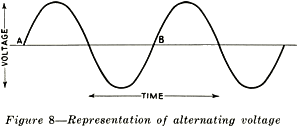17. The Production of Electricity by Rotating Machinery.- Electricity can be produced
dynamically, i.e., from motion and this method is always used when a large amount of
electrical power is desired. It is produced in this manner by means of
rotating machines called "generators" or "dynamos." In order to understand how
electricity is produced by such a machine it is necessary to know something about the
relation between electricity and magnetism.
In the discussion of magnetism it was stated that a magnetic field surrounded a
magnetic pole, and that this field consisted of imaginary lines of force which extended
from one pole to another. If a loop of wire is placed in the field in such a manner that
some of the lines of force pass through the loop, nothing occurs as long as the loop is
held stationary and the magnetic field kept at a constant strength, but, if the number of
magnetic lines of force which pass through the loop of wire is changed, a voltage will be
generated in the loop in proportion to the change in the number of lines through the loop
in a second of time. The number of lines of force which pass through the loop can be
changed by changing the position of the loop with respect to the magnet or by varying the
strength of the magnetic field, but, if the position of the loop is changed without changing
the number of lines of force through it, no voltage will be generated.

If the loop is closed, current will flow in the loop whenever a voltage is generated in it. Thus we have the prerequisites for electric power, namely, current and voltage.
If a loop of wire is rotated in a magnetic field in such a manner that the number of lines
of force through the loop is continuously changing in number, an alternating current is
generated. In order to change the alternating to direct current a mechanical device known
as a "commutator" is used. The production of electric power by generators will be
discussed in more detail in Chapter III.
18. Alternating and Direct Currents.- In speaking as we have above, of "alternating"
and "direct" current, the problem immediately presents itself -just what is meant by
these terms "alternating" and "direct" as applied to electricity? What is termed
a "pure direct current" is a very steady, even flow of current in one direction, such as is obtainable
from a battery.
8
